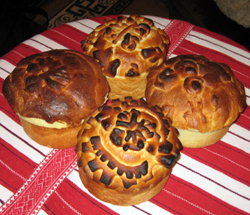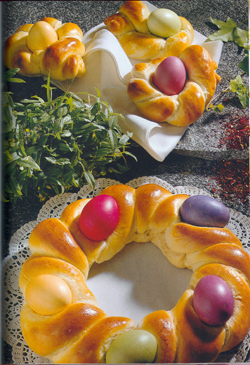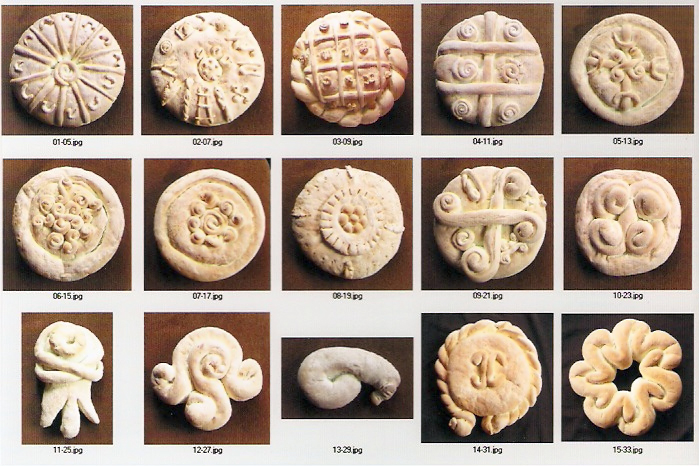Symbol of bread in celebration of the Resurrection of Christ
Celebrations dedicated to the joys of spring, rebirth in all ancient cultures and civilizations had a central place. In honor of the goddess of spring was celebrated in ancient Egypt, ancient Greece, ancient Rome, the Slavs it was the most joyous holiday (Goddess of Spring). In Christianity, Easter is a celebration of the holidays! Christianity without the Easter does not make sense. This is a holiday everlasting joy in honor of rebirth, when Christ conquered death. Easter is associated with the symbols of the Jewish holiday of Passover, as well as its place in the calendar. That is moveable holiday, which always falls on Sunday, the first after the full moon after the vernal equinox (the exact date depends on the Gregorian or the Julian calendar). For this holiday were established many traditions, especially the children happy. To this day, painted eggs, most red (although it used a different color) to donate eggs and the egg fights.
The ritual breads with significance has a central role in the celebration of Easter and occupies the central place on the table. Easter plait decorated with egg is the most common form of ceremonial bread. Orthodox Christians prepare more breads but only one carries to the church and this is the most decorated. The more flowers, slip on the bread - the more people will hang out, to live in harmony, peace, love ...
“Christ is risen!” - “He is risen indeed, alleluya!”




Christmas breads
There are many ritual and symbolical (ethical) meanings in religious Breads
Religious breads are present in every period of human life, from birth to death, end even after death. The story about religions breads is a story about the ethical and symbolic life of humans which has always been actual! Because of that this story should not be forgotten.



KRATKI ZAPISI IZ KULTURE HLEBA
SHORT NOTES FROM THE BREAD CULTURE
Istorija hleba - slikovnica / History of bread - picture book
KRATKI ZAPISI IZ KULTURE HLEBA
SHORT NOTES FROM THE BREAD CULTURE
Hleb u narodnoj magiji Balkanskih Slovena, Ljubinko Radenković
THE SLAVA LOAF (BREAD) IN THE SERBIAN TRADITION
 The Orthodox Serbs in the course of accepting Christianity distinguished themselves from other Orthodox believers (as well as from all other Christians) by developing and preserving their particular national domestic cult in a primary form throughout the centuries up to nowadays and by creating a special ritual called – the Krsna Slava, in which bread has one of the central places. More...
The Orthodox Serbs in the course of accepting Christianity distinguished themselves from other Orthodox believers (as well as from all other Christians) by developing and preserving their particular national domestic cult in a primary form throughout the centuries up to nowadays and by creating a special ritual called – the Krsna Slava, in which bread has one of the central places. More...
SVETI JEZIK VLAŠKOGA HLEBA
Sacred Language of the Vlach Bread
Vlaški ritualni hlebovi - The ritual breads of Vlachs

Traditional Christmas bread in Serbia
 The process of mutual permeation offers the authentic image and Christian tradition is best seen on the Serbian most important religious holidays, Christmas, Easter and other customs.Celebrating Christmas, for example, shows that the basic elements of the holidays, as well as burning the Yule log, the food that is on the festive holiday table, grilled meat (sirloin) and the role of polizajnik (the man who first congratulates the celebration of Christmas in the house of the host), phenomena that have roots in distant past.
The process of mutual permeation offers the authentic image and Christian tradition is best seen on the Serbian most important religious holidays, Christmas, Easter and other customs.Celebrating Christmas, for example, shows that the basic elements of the holidays, as well as burning the Yule log, the food that is on the festive holiday table, grilled meat (sirloin) and the role of polizajnik (the man who first congratulates the celebration of Christmas in the house of the host), phenomena that have roots in distant past.
CIVILIZACIJA HLEBA I PIVA
Dimitrije Vujadinovic
 Hleb i pivo su bili osnovne namirnice. Iako se većina ljudi s mukom borila da sastavi kraj sa krajem, postojala je opasnost i od preterivanja, bar medju bogatima. Učitelji su bili toga svesni. U Uputstvima Kheti , djak se upozorava sledećim rečima: Ako si pojeo tri hleba i popio dve krigle piva a telo hoće još, bori se protiv toga. Više...
Hleb i pivo su bili osnovne namirnice. Iako se većina ljudi s mukom borila da sastavi kraj sa krajem, postojala je opasnost i od preterivanja, bar medju bogatima. Učitelji su bili toga svesni. U Uputstvima Kheti , djak se upozorava sledećim rečima: Ako si pojeo tri hleba i popio dve krigle piva a telo hoće još, bori se protiv toga. Više...
BREAD IN EGYPT
EXPEDITION BY DIMITRIJE VUJADINOVIC
Ancient Egyptians, depending on their wealth and status, could have a varied diet, but central to their nourishment was bread.

